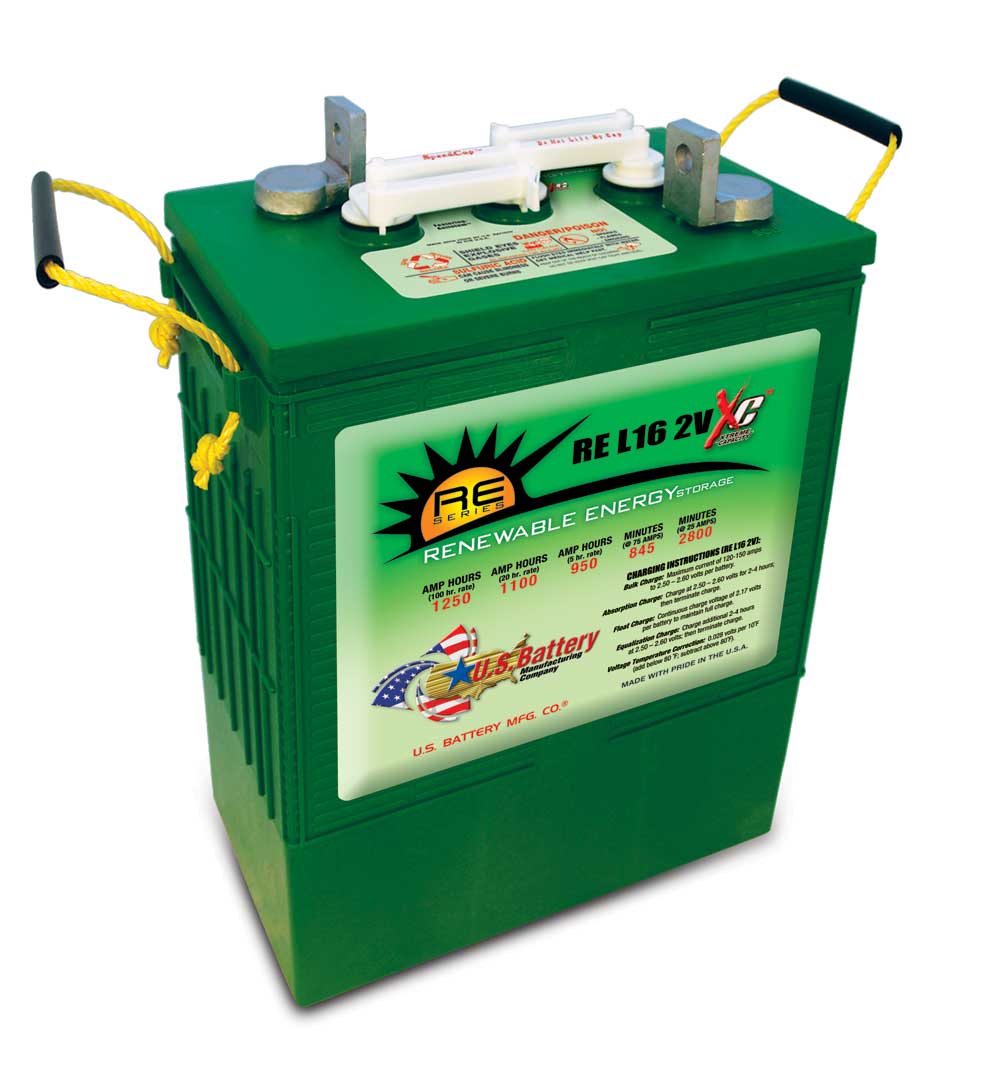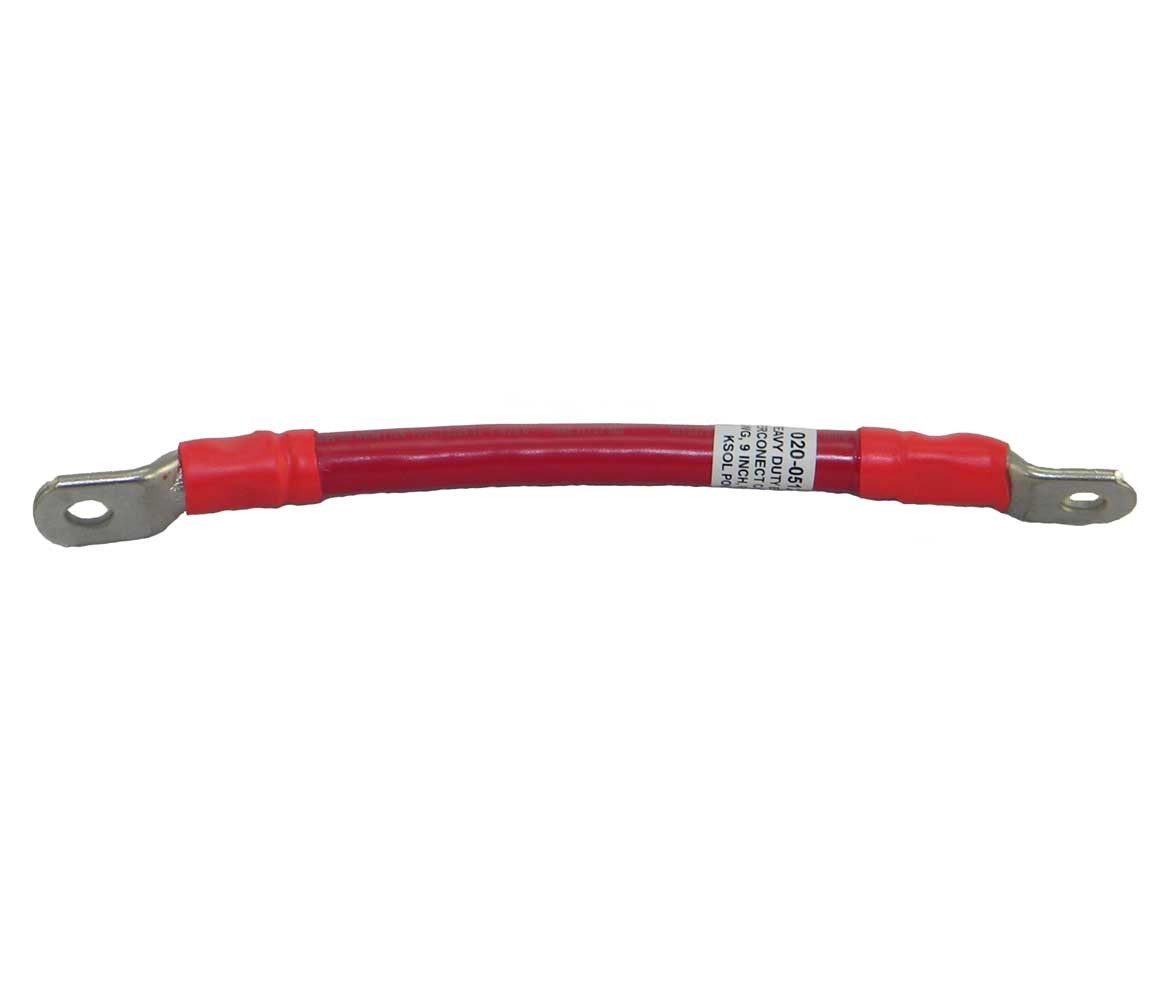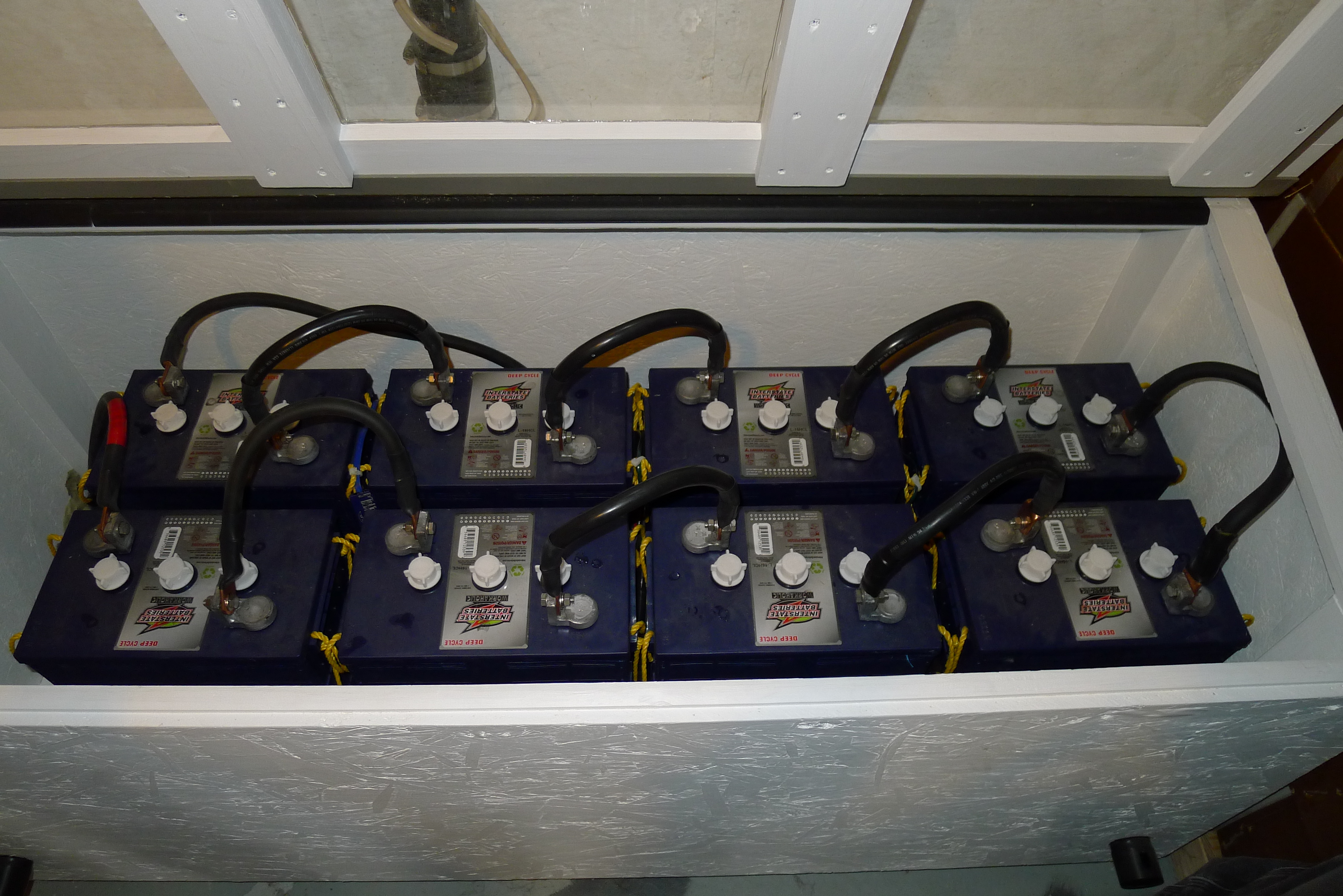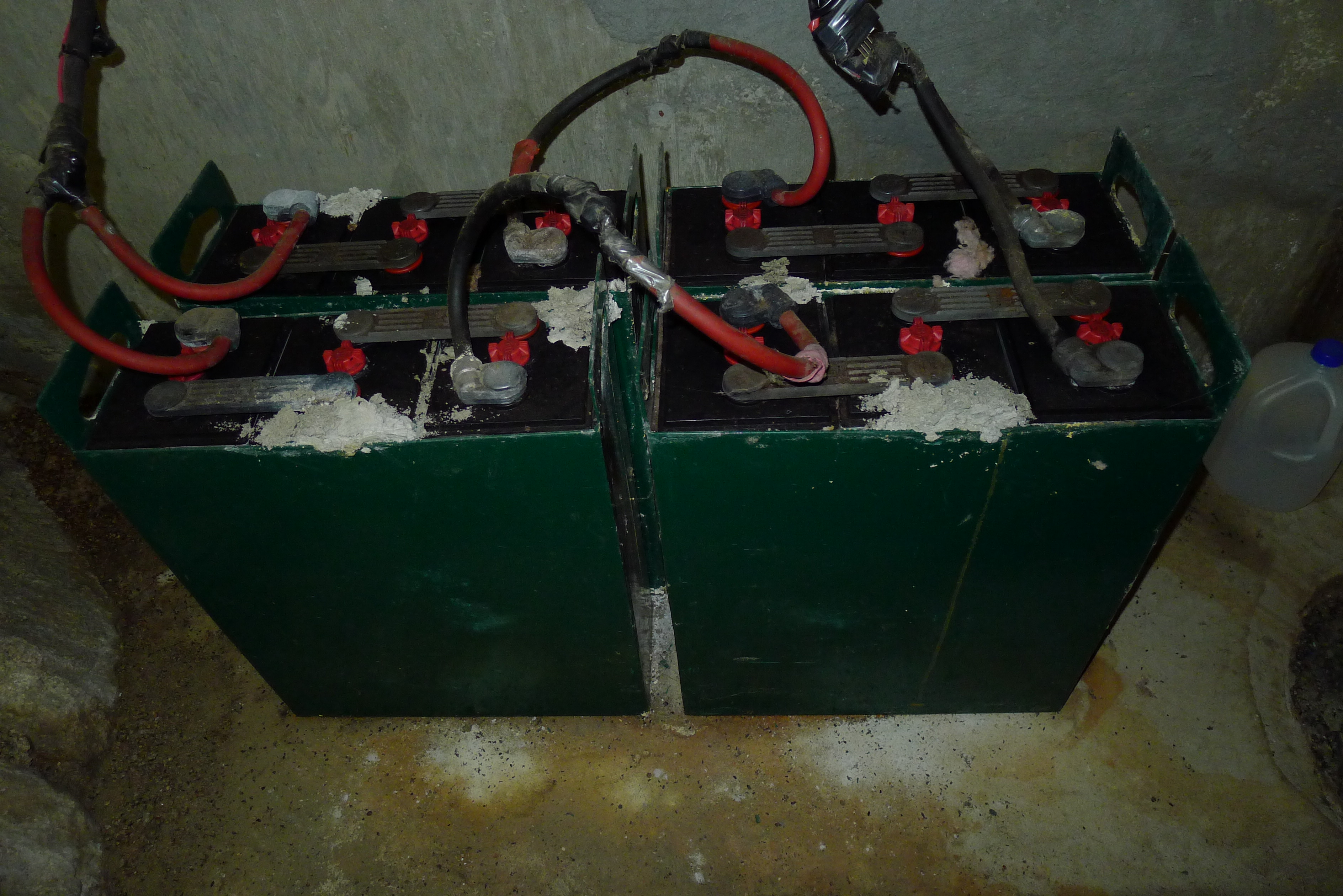A tidy install of eight 6-volt L-16s for a typical small, off-grid home.
Anyone who owns a vehicle likely already has a love-hate relationship with the starting battery inside. It's heavy, dirty, expensive, dangerous and always seems to fail at the most inopportune times. In an off-grid home, those irritating issues are compounded exponentially. A typical bank of batteries needed to power the needs of a small family in a modest-sized, energy-efficient home for only a few days is the size of a refrigerator, weighs over a ton, lasts less than ten years and costs over $3,000. Systems for greater electrical needs are often two to four times that size. If there were such thing as a compact, lightweight, long-lasting and affordable rechargeable battery, we'd have all been driving electric cars for decades, but no such battery yet exists. The one that starts your car or backs up your home electrical system right now is just Planté and Faure's late-1800s technology with a few minor, modern tweaks. The newest electric vehicles (and your smartphone and laptop computer) use new Lithium-ion battery technology, but it's still far too expensive for home backup power—a battery bank comparable to the example above would cost well over $20,000, more than most folks pay for an entire off-grid solar power system! Equipment that plays nice with Li-ion cells is also rare and expensive, and the technology has no track record yet in the home renewable energy industry.
Battery types for home backup power
With only a few rare exceptions (see sidebar, bottom of page), the batteries in cars, trucks, and new or existing home-scale renewable energy backup systems today are formulated with lead and sulfuric acid—the “lead-acid battery.” Lead-acid batteries come in two main varieties, flooded and sealed. Flooded are the most common, most durable and least expensive. The caps on each cell are vented, so that gases released during charging and discharging can escape. During the electrochemical reaction, water is split from the electrolyte and must be replaced with distilled water on a regular basis. The batteries will spill electrolyte if tipped, a corrosive situation that will ruin almost anything it touches, and a very time-consuming liquid to replace. Sealed lead-acid batteries won't spill electrolyte at any angle. They were first invented for industrial applications where the battery could be mounted on its side, or in unstable situations like a boat in rough seas or a camper on rough roads. They are often called “gel cells” or “valve-regulated lead acid batteries (VRLA).” The drawback of these batteries is that if not charged with the exact regimen specified by the manufacturer, they lose water from their gelled electrolyte—and you have no way to replace it. Absorbed Glass Matt (AGM) batteries are the latest in the sealed lead-acid battery world. They have the advantages of not spilling electrolyte when tipped (or even when broken), and that internally they chemically recombine battery gases into water again. You don't have to add water to the electrolyte, and they are much more tolerant of charging problems. The downside is that AGMs cost about twice as much as flooded batteries, and are not available in as many size options.
Deep-cycle batteries – aren't
“Deep-cycle battery” is probably the most misleading term in the history of electricity. All batteries—even the latest and greatest high-tech marvels—are rated for how many “cycles” they can perform before they degrade so far that you need to replace them. A cycle means going from full charge to 50 percent depth of discharge (DOD) and back to full again. Manufacturers may also rate their batteries for cycles to 80 percent DOD and 20 percent DOD. An automotive battery is designed to put out a huge amount of energy in a short time to turn your car's starter motor, even in cold temperatures, and then be quickly charged back to full by the car's alternator as you drive. So, inside there is a large number of very thin lead plates, which gives more surface area for that electrochemical reaction we depend on. You'll see ratings for “Cold Cranking Amps” on car batteries when you shop at the auto parts store, and if you live in a very cold climate you probably already choose batteries with higher CCA numbers. But for home renewable energy storage, higher CCA is exactly what you don't want. Those thin plates don't tolerate much abuse and fail quickly if not recharged promptly. That's no problem in a car; the battery rarely gets below 10 percent DOD and can survive thousands of shallow cycles like that. But in a home power system, automotive batteries would be lucky to survive a year before failing completely. “Deep cycle” batteries for boats, RVs, forklifts and home renewable energy systems are built with fewer, thicker plates. They can't put out the instant amperage you need to start a truck at 20 below zero, but they don't degrade as quickly if it's going to take some time to charge them back up to full, such as if your home runs on solar or wind power. They don't thrive on this treatment, though—they simply survive it a while longer than a car battery. A typical starting battery can only take around 100 cycles to 50 percent DOD, a renewable energy battery around 1500 cycles and a forklift battery up to 4000 cycles (and beyond). In industrial applications batteries are hit hard (50 percent DOD or worse) on a daily basis, but most home battery banks are designed to provide more gentle power for a couple days to a week, and in the process never fall below 30 percent DOD, or even better 20 percent. As the batteries approach 50 percent DOD, the homeowner can run a backup generator for a few hours to get things charged up again (or the system computer can start and stop the generator on its own). 50 percent DOD should only happen in an emergency, like when your generator won't start during a blizzard.
Battery grades
I tend to classify batteries into four main groups: starting, marine, commercial and industrial. I've already explained why starting batteries won't cut it in an off-grid situation. Marine batteries are slightly better, and are convenient for tiny power systems because they operate at 12 volts, like a car. They can work well in boats, RVs and campers but they don't hold much energy, and you can expect only one or two years lifespan in a home or cabin application. Commercial batteries are by far the most popular in home power systems due to reasonable cost, high capacity and good resistance to abuse, with the T-105 and L-16 types used the most. These numbers are simply “form factors,” just like with AA and D batteries; many different companies manufacture them and they are all about the same physical size, with slight differences in capacity and performance. T-105s are commonly used to power golf carts, and L-16s were designed for electric floor sweepers. Those are very demanding uses, so both battery types also perform quite well in home RE systems. A golf cart battery typically measures about 10 x 11 x 8 inches, weighs in at 67 pounds, produces 6 volts DC and can store about 225 amp-hours of energy (see the jargon sidebar). An L-16 is also 6 volts, has about the same footprint, is twice as tall, weighs twice as much and stores about twice the energy.
A 6-volt golf cart battery in a T-105 form factor. Photo courtesy Trojan Battery.
For smaller installations or where transportation to remote sites is a problem, I always recommend golf cart batteries. A normal human can lift one without much strain, they are easy to fit into tight spaces and you can transport them more easily to remote locations. They also make excellent “training batteries” for folks with modest electrical needs who are new to off-grid living. If they make a mistake and ruin a battery bank, the financial burden of replacing it is not so high. For larger installations, L-16s are usually hands-down the best, most affordable choice. For my potential off-grid clients, I often draw the deciding line between T-105s and L-16s squarely at the refrigerator door—if you'll be using a typical electric fridge and/or freezer, you need L-16s. If you'll be chilling with propane appliances instead, golf cart batteries could do an excellent job at running everything else. That seems kind of arbitrary, but a fridge and freezer are large, essential loads, and you don't have much control over when they need to turn on and off to keep food from spoiling. During a long stretch of bad weather with a broken backup generator, you'll appreciate the extra capacity and durability of L-16s.  A 2-volt commercial battery in an L-16 form factor, designed specifically for renewable energy systems. Photo courtesy US Battery. Industrial batteries are amazing things, commonly found in forklifts, mining vehicles and large renewable energy installations, and each battery gives out 2 volts. They are by far the most long-lasting and abuse-resistant battery out there, and in a home RE system lifespans of 10 to 20 years are common. But, ouch, the price! They cost two to four times as much as L-16s for the same capacity, and are extremely heavy, bulky and difficult to move. You're not going to be loading any of these into and out of your pickup truck by hand, as even a small one weighs in at over 300 pounds.
A 2-volt commercial battery in an L-16 form factor, designed specifically for renewable energy systems. Photo courtesy US Battery. Industrial batteries are amazing things, commonly found in forklifts, mining vehicles and large renewable energy installations, and each battery gives out 2 volts. They are by far the most long-lasting and abuse-resistant battery out there, and in a home RE system lifespans of 10 to 20 years are common. But, ouch, the price! They cost two to four times as much as L-16s for the same capacity, and are extremely heavy, bulky and difficult to move. You're not going to be loading any of these into and out of your pickup truck by hand, as even a small one weighs in at over 300 pounds.
Battery capacity
Battery capacity is rated in “amp-hours,” a confusing term designed to keep renewable energy consultants like myself employed because hardly anyone understands it. An amp-hour (a-h) means the battery can store and release one ampere of current for one hour. But at what voltage? I find watt-hours (w-h) and kilowatt-hours (kWh, 1,000 w-h) to be far easier to work with, as solar panels, generators, lights and appliances are all rated in watts of output or consumption, so I use watt-hours in all the off-grid electrical classes I teach. Fortunately, the conversion is easy—just multiply the battery's amp-hour rating by its voltage to get watt-hours. Battery capacity also changes depending on how fast you are discharging the battery—the higher the rate, the lower the capacity. So a battery that holds 400 a-h when discharged over the course of 20 hours (called a C/20 rate) might hold only 300 a-h if discharged in only 5 hours (C/5 rate). Also remember that you should never discharge any battery to over 50 percent DOD, so if your calculations show you need 10 kWh of backup storage for your home, you really need to purchase a 20 kWh battery bank.
Battery killers
Most batteries don't die of natural causes, they are murdered! The most common culprits are loss of electrolyte, chronic undercharging, too many deep discharge cycles, corroded connections and heat. In a flooded lead-acid cell, it's critical that the liquid electrolyte level remain above the top of the plates at all times. If it drops below, permanent damage occurs quickly. It's an easy problem to prevent; someone simply has to check the electrolyte level at least monthly, and top up with distilled water as needed. In remote and automated systems where humans can't keep an eye on things, AGM batteries are often used to reduce these maintenance tasks. Chronic undercharging is a more insidious killer. You might be surprised that I don't list overcharging as a prime suspect instead. But in reality, overcharging a flooded lead-acid battery is no big deal, as long as you keep adding distilled water to keep the electrolyte level up. The damage from undercharging builds up slowly over the course of months or years, with the only symptom that someone finally notices that “gosh, sure seems like these batteries don't hold much of a charge anymore.” The cure is to install a relatively inexpensive battery monitor, size your solar array correctly and scrupulously follow the battery manufacturer's instructions for programming your charge controllers.
Severe corrosion on the terminals indicates bad connections. These 6-volt industrial forklift batteries had to be replaced, but on the bright side served for 14 years in an off-grid solar power system before failing.
Loose and corroded battery connections are another problem that can creep up on you slowly. Batteries are by nature low voltage, and that means high amperage and frequent heating and cooling cycles in the wires and connectors. This can cause them to eventually loosen, creating high-resistance hot spots, and corrosion begins to build up internally—right where you can't see it starting. By the time you can see green, powdery crud building up on the outside of the battery terminals (photo) there's already likely a bad connection. And that means one or more batteries in the bank are getting less charging current than the rest, which over time will cause premature battery failure. You might also be surprised that I don't list cold temperatures as a battery-killer, but heat instead. Most people who live in northern climes have experienced poor automotive battery performance during cold temperatures and even frozen and cracked cells. But lead-acid batteries can survive just fine at temperatures of 50 below zero and worse if they are fully charged, though they do become sluggish. Their performance bounces right back to normal when temperatures rise again, with no permanent damage. It's all about the electrochemical reaction between lead and sulfuric acid. When a lead-acid battery is fully charged, the electrolyte liquid or gel inside is a very strong and corrosive acid. When the battery is discharged, the electrolyte is mostly water...and water freezes quite readily. There are two sides to the chemical reaction going on inside a battery; a “good” one that lets us store and release electrical energy, and a “bad” one that happens when the battery is not fully charged, smothering the internal plates with sulfer that can't be easily removed. Both are slowed down by cold temperatures, and sped up by heat. But the bad one (called “sulfation”) causes permanent damage to a battery, while the good one doesn't. The ideal temperature for a battery, both in operation and in storage, is about 70 degrees F. Batteries also lose charge when just sitting and doing nothing; think of them like a bucket with a hole in the bottom. The phenomenon is called “self-discharge” and is the reason that vehicles which sit for a long time between uses—like fire trucks, yard tractors and small airplanes—are usually stored connected to a small trickle charger to compensate for these losses.
Battery installation
Batteries hold a tremendous amount of energy, more than enough to quickly start a fire. It's critical that they be installed correctly and safely. Before you attempt to install, remove or maintain a battery bank, be sure to read the safety guidelines I've put together in the sidebar. The National Electrical Code requires a sealed, vented battery enclosure with only a few exceptions. Commercial enclosures made from steel or plastic are available but very expensive, so most folks build the enclosure out of wood. For the floor, a concrete pad is ideal (see the sidebar). I'm surprised wood is even allowed—improperly installed and maintained battery banks are a leading cause of fires in RE systems. So I recommend lining the interior of the wooden box with cement backer board, which won't burn. Because the gases emitted by batteries are both explosive and toxic, you should never install any kind of electrical equipment inside a battery enclosure. In most climates it's not necessary to insulate the battery enclosure, but in extremely cold climates it can be useful, as batteries do make heat when charging and discharging. In extremely hot climates, you may even need to install the batteries in an underground enclosure to keep temperatures down close to the recommended 70 degrees F. The lid of the box should be slanted, with the outdoor vent screened off to prevent rodents from entering, with the vent placed at the highest part of the box so that the flammable and explosive (but lighter than air) hydrogen gas the batteries emit will naturally exit. The other reason for slanting the lid, in my long experience with off-grid power systems, is simply so that the homeowner won't have a flat surface on which to pile tools, owner's manuals and other clutter that impedes easy access for maintenance! 
A professionally-fabricated battery interconnect cable.
The short, thick wires that interconnect the batteries in a bank and then connect it to the rest of the power system are critical for both safety and performance, and must be sized and installed correctly. The wire size needed is determined by the maximum output amperage the battery bank will have to supply to the inverter (I'll discuss inverters in a future issue of Countryside), and it's best to follow the inverter manufacturer's guidelines. The wire will in any case must be thick, flexible and expensive, much like welding cable, and generally at least #0 AWG unless your inverter will be very small. In fact, welding cable works very well for battery interconnects, but for a variety of arcane and obscure reasons doesn't meet code. If you choose to use it, you'll be fine, and I promise I won't tell. The lugs at each end of the interconnect cables are critical, too. Set-screw lugs are commonly available, but I advise against them—too many parts that can loosen over time. Professional installers use large copper crimp lugs, installed with a special crimper, and seal the connection with glue-lined heat-shrink tubing (photo). Most local battery distributors will have the tools and supplies needed to make excellent interconnects, and it's often quite cost effective to have them build these cables for you. Before connecting the cables, coat the battery terminals with a protective spray, or just plain petroleum jelly. This will help keep corrosion from creeping in.
Maintenance
I recommend a quick and easy (hah!) battery maintenance on a monthly basis. Mark your calendar and post a maintenance log sheet on the battery box. Be sure to wear full personal protective equipment as described in my safety guidelines sidebar. Check all interconnect cables for loose connections by gently trying to wiggle them. Check all battery terminals for corrosion—the dreaded “green crud.” If anything is loose or you see any green stuff at all, shut down the entire power system with the master DC disconnect, remove the cable lug from the battery terminal, and clean everything with a wire brush. Then re-coat the terminal with petroleum jelly and reconnect. Clean the top of each battery with a damp rag to remove dust and chemicals. If there is chemical buildup, add some baking soda to the water for your rag. Do not let this cleaning solution enter the holes on the sides of the vent caps under any circumstances! The operative word here is “damp.” Remove each battery cell vent cap and check the electrolyte level with a flashlight. Add distilled water (and distilled water only) up to the “full” mark inside and replace the cap.
At the end of the day
I hope I've shed some light on the mysteries of battery energy storage. A battery bank is the heart of every off-grid renewable energy system, and also the part most likely to fail. By choosing wisely from the very beginning, you'll maximize the lifespan of your batteries and lower their lifetime cost per kilowatt-hour—but I regret to inform you that at some point in the future, you'll still have to remove and replace them. Sigh. My back is hurting just thinking about it... By Dan Fink Originally published in Countryside Magazine, March/April 2014
{SIDEBAR} Battery safety
Batteries are dangerous, even your car battery! Here are some safety guidelines. Whenever you are working with batteries:
- Wear safety glasses with side shields, nitrile gloves, work shoes and work clothes.
- Keep a large box of baking soda nearby to neutralize acid spills.
- Wear a dust mask or respirator when cleaning corrosion from battery terminals.
- Lift batteries only by their built-in handles, or use a battery lifter.
- Wrap the wrench you'll be using for tightening battery terminals with electrical tape to prevent accidental shorts.
{SIDEBAR} Battery Myth
“Don't put your batteries on a concrete floor—the electricity will leak out.” This one is false. In fact, a concrete floor is an excellent place for batteries, as the large thermal mass evens out the temperature of all the cells, and an accidental acid spill won't damage concrete. But back in the day, this myth was true! The earliest lead-acid batteries encased the cells in glass, inside a tar-lined wooden box. If the wood swelled from a damp concrete floor, the glass could crack, ruining the battery. Later battery designs used primitive hardened rubber cases that had a high carbon content. After long enough contact with damp concrete, circuit paths could form through the carbon in the rubber out into the concrete, discharging the batteries. Fortunately, modern plastic battery cases have solved all these problems, and I recommend a concrete pad to all my clients for all new battery installations.
{SIDEBAR} The Edison Battery
In 1901 Thomas Edison developed a new type of battery using nickel and iron for the plates, and alkaline potassium hydroxide for the electrolyte. He intended them to be used in electric cars and for automotive starting, and you'll see them referred to as nickel-iron (NiFe) or Edison cells. They are making a bit of comeback in the renewable energy world and are especially popular among “preppers” for one reason—they are extremely long-lasting and resistant to abuse from over- and undercharging. It's not uncommon for 50-year-old NiFe batteries to still be functioning just fine. Unfortunately they also have major disadvantages, which are why they never caught on for Edison's planned uses. They are very expensive to manufacture, don't store as much energy for their size and weight as lead-acid batteries, have a high self-discharge rate, are very inefficient when charging or discharging, and are subject to thermal runaway if not charged carefully. Currently they are only made in China, and there is only one company in the USA that imports them. That company is currently working with charge controller manufacturers to develop programming to better suit NiFe cells. I usually advise clients to avoid NiFe and go for industrial lead-acid batteries instead, but I can't deny that the idea of a battery that can last decades is very attractive. If you are going to use NiFe batteries, I recommend that you size both your solar array and battery bank at about twice the normal capacity, and be certain that all your charger equipment has specific settings just for NiFe.
{SIDEBAR} Are batteries “green?”
With their toxic and corrosive mix of lead and acid, it's hard to imagine batteries as environmentally friendly. But according to the US Environmental Protection Agency, 97 percent of lead-acid batteries n the US are recycled, with the lead and plastic going to make new batteries and for other uses.


